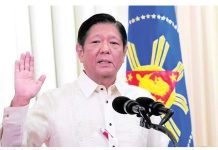
ILOILO City, ILOILO – On Nov. 4, jw.org, the official website of Jehovah’s Witnesses, reached an unprecedented translation milestone – it now includes articles, videos and audio content available in 1,000 languages, including 24 major and indigenous languages in the Philippines. The latest addition from the Philippines is the Blaan (Sarangani) language, which is spoken by an indigenous people in Southern Mindanao.
John Yunker, author of The Web Globalization Report Card, states: “The internet connects computers, but languages connect people…The jw.org website shows great respect for those who speak languages that may not be supported by the Fortune 500. But on a larger level, jw.org is ahead of the curve. Even Facebook, with support for more than 100 languages, has a long way to go. And while the jw.org effort is volunteer-driven, it even outpaces the world’s most popular crowd-sourced website, Wikipedia, with support for more than 280 languages.”
Mr. Yunker adds: “When considering whether or not to translate into a new language, commercial websites usually limit their efforts to languages that will be significantly profitable. For Jehovah’s Witnesses, though, profit is not the motive. Their goal is to translate the Bible’s message so that it is accurate, clear, and easy for readers to benefit from.”
Some 10 years ago the Department of Education (DepEd) encouraged the use of the mother tongue in educating elementary students. Researchers recognize the benefits of learning one’s mother tongue or first language. When it comes to Bible education, Jehovah’s Witnesses believe that all peoples should be given a chance to learn God’s Word in a way that touches their hearts. The efforts of Jehovah’s Witnesses to translate into native languages are appreciated by many in our country’s indigenous communities. One of our volunteers for the Blaan community in Sarangani reports that the people are pleasantly surprised to hear a video recorded in their mother tongue. One local who listened to the translated video said in B’laan, “too fye fanlinge,” which means, “it is so beautiful to listen to.”
Much of the translation is done by well-trained volunteers who work in some 350 remote translation offices (RTOs) around the world. To ensure the translators are using the clearest and most current vocabulary, where possible, RTOs are located where there is a high concentration of native speakers, allowing the translators to be immersed in the language. In such an environment, the translators are also able to field-test terms and expressions before using them in publications. In the Philippines there are five established RTOs across the country. These are located in Tuguegarao (for Ibanag), San Carlos City (for Pangasinan), Bacolod (for Hiligaynon), Naga City (for Bicol), and Tacloban (for Waray-waray). A sixth RTO is being constructed in Zamboanga City for the Chavacano language. The three major languages, Tagalog, Cebuano, and Iloko are being translated from the Witnesses’ national office in Quezon City. A fourth language, Filipino Sign Language, is also being translated at that office.
“[When] analyzing the translation work [of Jehovah’s Witnesses],” states translation scholar Gerhard Budin, “it becomes clear that the basic principles of translation studies, as well as best practices in practical translation work, are fully respected. This manifests itself in easy-to-read texts in multiple language versions of the journal The Watchtower, for example, while addressing a broad audience of people in each language community.”
An achievement in translation
Gerrit Lösch, a senior member of the Witnesses’ Governing Body, states: “Our translation work has a long history dating back to the late 1800’s and has increased dramatically in recent years.” Geoffrey Jackson, also a member of the Governing Body, adds: “It took us a little over a hundred years to reach 508 languages in January 2013. But it’s remarkable that in just under seven years we have nearly doubled our translation production – from 508 languages to 1,000.” In addition to offering a wealth of downloadable material in 1,000 languages, jw.org’s home page and other pages can be navigated in an unprecedented 821 languages, making it the most widely translated website in the world.
“It’s remarkable that in just under seven years we have nearly doubled our translation production – from 508 languages to 1,000.” – Geoffrey Jackson, a member of the Governing Body
“Translating into and publishing in so many languages can pose special challenges,” explains Izak Marais, who directs the Translation Services group at the world headquarters in Warwick, New York in United States of America. “At times we wanted to publish in a less common language, but not all the characters were available for that language. So, over the years, we have provided artwork for countless characters and font sets, allowing us to produce printed publications in hundreds of languages. Similarly, we have overcome many challenges to make our publications available in the many languages on jw.org. In fact, many of those 1,000 languages have no other publications available on the web.”
Clive Martin, who directs the programming division responsible for publishing content on jw.org, added: “One challenge we have faced is how to represent an article in hundreds of languages, with different scripts and layouts, on a single website. For example, 21 of the languages we support are written from right to left. For the 100 sign languages we support, we had to create a unique design that is easy for deaf users to navigate.”
As early as 1881, the Bible Students, as Jehovah’s Witnesses were then known, began preparing for the production and distribution of Bible literature in languages other than English. “Back then,” says Mr. Jackson, “likely no one could have imagined translating into 1,000 languages!”
Jehovah’s Witnesses in the Philippines quick facts
- 226,062: Number of Jehovah’s Witnesses in the Philippines
- 3,499: Number of congregations in the Philippines
- 24: Numbers of Philippine languages literature is being translated into
List of local and indigenous Philippine languages represented: Abaknon, Bicol, Blaan (Sarangani), Cebuano, Chavacano, Filipino Sign Language, Hiligaynon, Ibaloi, Ibanag, Ifugao, Iloko, Inakeanon, Itawit, Ivatan, Kamayo, Kankanaey, Kinaray-a, Maguindanao, Maranaw, Pangasinan, Surigaonon, Tagalog, Tausug, Waray-Waray.
Jehovah’s Witnesses Global Statistics
- 8,579,909: Jehovah’s Witnesses worldwide
- 240: Lands where Jehovah’s Witnesses worship
- 119,954: Congregations of Jehovah’s Witnesses worldwide
- 20,329,317: Peak attendance at meetings of Jehovah’s Witnesses worldwide
- 1,004: Languages featured on jw.org, the official website of Jehovah’s Witnesses







